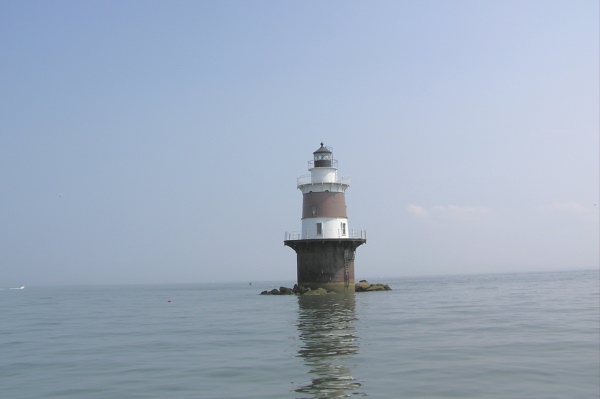Ladybug’s (Darlene’s) LI Sound trip shows eastern Long Island Sound lights. My trip was to see western Long Island Sound lights. Between the two of us, you’ll get to see most of the lights in CT.
There are 19 lighthouses in CT and 1 Memorial Light (Avery Point). Although we’ve seen many of these lights before, most of our pictures were taken from land. So, when the chance to see CT and NY lighthouses up close and personal this past weekend presented itself, we opted to miss Stan’s annual family reunion and join Captain Barry Natale, Sound Navigation, LLC aboard his 37 foot, twin diesel-powered vessel, the SEAPORT EXPRESS. We haven’t heard or read of anyone else offering boat trips to many of these lights–especially Great Captain Island for which I’ve been haunting the internet for many years. The Seaport Express is certified by the United States Coast Guard to carry 27 passengers for hire, but our trips (Saturday and Sunday) had 11 passengers and 20 passengers respectively and that was comfortable. The rain held off for both days, except for a short squall on Saturday’s trip.
We left Veteran’s Memorial Park in Norwalk, CT at 11 AM with a total of 11 passengers and Captain Barry and Jason, his assistant. First stop was
Great Captain Island, CT. Situated on the largest of a 3-island group about a mile offshore from Greenwich, CT, the other two islands are Little Captain (Island Beach) and Wee Captain, which is attached to Great Captain by a sandbar. Located near the main shipping lanes of LI Sound and surrounded by a number of small islands, ledges, shoals, and other maritime hazards, the island was an ideal spot for a lighthouse. The first lighthouse was a 30' tower built of rough stone that was described as badly constructed. The 5-room keeper’s quarters, a stone structure separate from the lighthouse tower, was in better shape.
A replacement lighthouse was built on the site in 1867 using a design shared by other area lighthouses (Sheffield Island, CT, Morgan Point, CT, Old Field Point, NY, Plum Island, NY, and Block Island North, RI)–a stone keeper’s dwelling with a cast-iron light tower on top towards the front.
A steam-driven fog whistle was added in a separate new structure in 1890 and in 1905 a duplicate foghorn powered by 13 hp oil engines went into service. Local residents complained of not being able to sleep at night due to the noise and adjustments were made.
A complete restoration of the lighthouse was to start in 2007, but we did not see any signs of that from our vantage point on the Seaport Express. Although the island is open year round and a ferry runs during the summer months, only Greenwich residents and their guests are allowed on the ferry and onto the island.
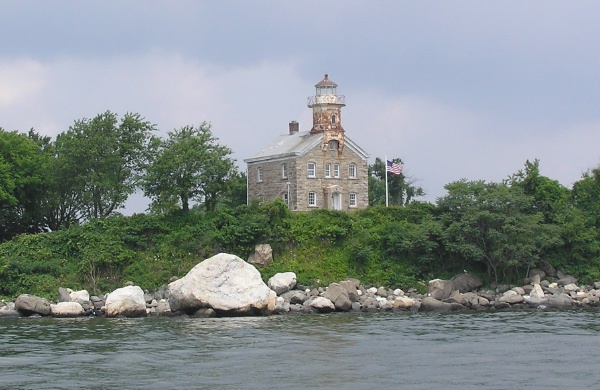
Next stop was literally a stop and tour of Huntington Harbor (Lloyd Harbor; Huntington; The Castle) L.I., NY. Captain Barry has permission to dock at the site where we were given an informative talk by one of its volunteers.
The first harbor lighthouse was a 2-story wood-framed keeper’s house built in 1857 on a brick foundation with a square masonry tower attached to the back. The lantern was reached via a 2nd-story window and ladder.
The present Huntington Harbor Lighthouse was completed in 1912, following destruction of the original by fire on November 12, 1947. It is a 1-story dwelling with basement and an attached square tower–its styling has been described as belonging to the Venetian Renaissance or Islamic temple genres and designed by a Beaux Arts or Art Deco architect. The basement contains a water cistern and 2 fuel storage rooms. The lighthouse’s foundation, a round reinforced concrete caisson, was cast ashore and then barged to the site. Once in place, additional concrete was poured around the cistern and room forms to produce a solid base. It is the oldest reinforced concrete lighthouse on the East Coast. Point Arena in California is America’s oldest.
The 4th-order Fresnel optic, first lighted on November 15, 1857, did not have a sufficient elevation for eastbound ships to pick up its fixed white light. In 1883 the kerosene-fed lens’ characteristic was changed to show a fixed red light of greater intensity. By the early 1900s, both the public and politicians were clamoring for a new lighthouse at the entrance to Lloyd Harbor. With the completion of the new light station, the old Lloyd Harbor beacon was discontinued on June 16, 1912.
The new lighthouse’s 4th-order Fresnel optic, transferred from the older tower, was fully automated in 1949 and removed from the site in 1967.
Owned by the U.S. Coast Guard and Leased to the non-profit “Save Huntington’s Lighthouse,” the site is listed in the National Register of Historic Places as Lloyd Harbor.
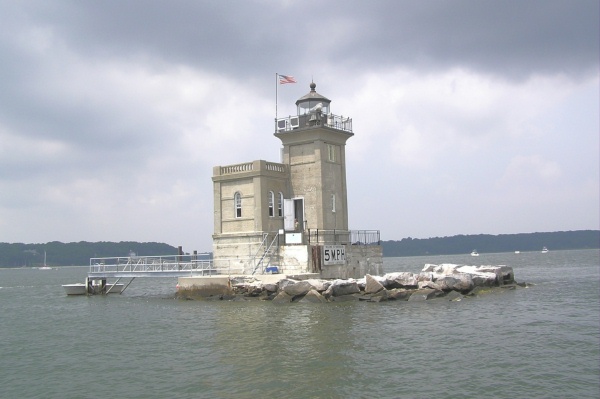
We then moved onto Eatons Neck Lighthouse, NY. One of America’s first lighthouses to be erected during the Colonial Revival design period (1790-1852). Located on a high bluff 144' above the sound, it warns ships off the rocky shoal that has seen more shipwrecks than any other shoal, outcropping, or cape on Long Island’s northern shore. One storm in December of 1811 was responsible for the loss of 60 ships and most of their crews.
The height of the original freestone lighthouse was raised to 73' in the late 1790s. Its tower was lined with brick in 1868. The original copper funnel used to dissipate upwards into the ventilator ball the heat generated by the huge lens remains under the dome and above the lens. The little vents below the lantern are copper ventilators that allow an intake of a cooling flow of air up and through the lens.
The original lighting apparatus, probably a multi-wicked spider lamp, was replaced in 1838 with another one of Lewis’ Argand-styled devices, consisting of 12 lamps with 13" reflectors. In order to increase the light’s nominal range, different lamp/reflector combinations were tried in 1842 and 1850. In 1858, after the tower had been altered and strengthened (1856-’57) to accept a larger lantern, the lighthouse was reequipped with a single shale-oil lamp and a Henri LePaute 3rd-order Fresnel lens. The electrically-powered lens continues to generate its light for almost 100 years of service.
One of Eatons Neck’s two foghorns, installed in 1871 and replaced in the 1940s, was found on the beach below the bluff, apparently having toppled off the eroding cliff from its resting site. The fog horn was to be restored and displayed on station, but the station does not have it.
Owned by the U.S. Coast Guard, the station was scheduled for demolition in 1969, but was saved four years later after the Northport Historical Society submitted the historical and survey data required to have Eatons Neck in the National Register of Historic Places. Endangered due to its location on the edge of a cliff, the Coast Guard is faced with spending an estimated $10 million to stabilize the bluff and save the station.
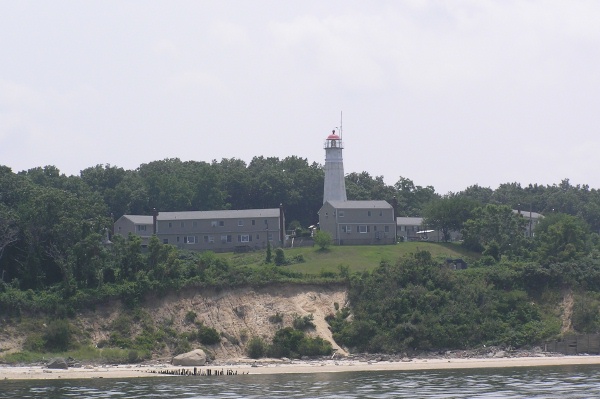
The next light was Greens Ledge Lighthouse, CT, located on a rocky reef southwest of Sheffield Island, is a cast-iron structure, 52' tall that rests on a cast-iron caisson pier. It has an exterior of bolted cast-iron plates and an interior lined with brick. The tower has four interior decks and is surmounted by a gallery-equipped watchroom and lantern.
Its original light characteristic (flashing red), produced by a 5th-Order Fresnel lens installed in February 1901, proved to be a poor warning beacon. The lantern received a 4th-order Fresnel lens in May 1902 and the light's characteristic was changed to a combination of fixed white and flashing red. The lantern contains a modern rotating optic today, installed and automated in 1972.
The white (upper half) and brown (lower half) tower leans a bit as a result of damage incurred during September 1938 by a tremendously destructive hurricane. Public concern saved the old iron tower from being dismantled in 1971. The lighthouse is unmanned and boarded up.
Owned by the U.S. Coast Guard, the light is listed in the National Register of Historic Places.
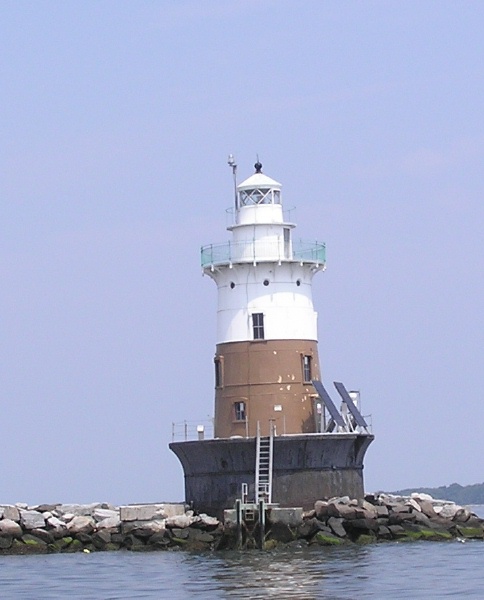
Captain Barry also has permission to dock at Sheffield Island (Norwalk Island, Norwalk, Smith Island) Lighthouse, CT, where Stan and I ate lunch while the others were given a tour of the lighthouse. We’d been here before with NELL and opted out of another tour. That reminds me, NELL members are given a discounted rate for this cruise, billed as “Castles of Long Island Sound”. If you’re in the area and wish to see lighthouses not normally viewed by other cruises, I recommend contacting Barry Natale at barry@soundnavigation.com Now, back to lighthouses.
Sheffield Island Lighthouse was built by Captain Theodore Smith in 1868. It is a 2½-story dwelling and a tower that protrudes from the west gable end rises to a height of 46'. The structure's walls are constructed with rough finished gray, brown and pink granite-like (gneiss) stone. The tower is built with bolted cast-iron plates. It had a 4th-order Fresnel lens.
Listed (1/19/1989) in the National Register of Historic Places as Norwalk Island Light.
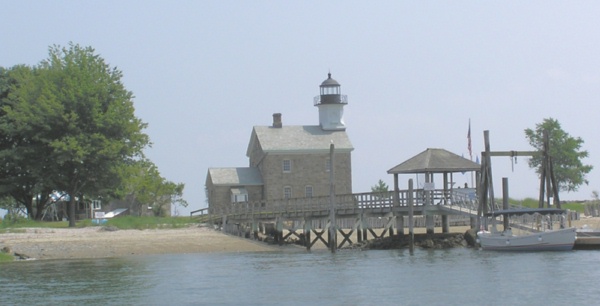
The next light was Peck Ledge Lighthouse, CT, completed in 1906, is the last lighthouse built in Long Island Sound. It is a cast-iron aid built atop a concrete filled cast-iron caisson. The truncated, boiler-plated tower is brick lined and has been assembled in three stages. The three levels contained living space for two keepers and storage areas. The tower is topped with a circular watchroom supporting the lantern. The lantern still has its original curved and diamond-shaped storm panes displaying a crisscross pattern.
The 54'-tall lighthouse was activated on July 10, 1906. Its optics have been changed several times: a flashing 4th-order Fresnel lens was the first, incandescent oil vapor replaced kerosene in 1932 (its luminous intensity was rated as 37,000 candlepower), the classical lens was removed and replaced by an acetylene-powered aerobeacon in 1939 (lowering its intensity to 210 candlepower), a 375 mm lens in 1989 (further reducing its candlepower) that was mounted on top of the lantern's roof, and, finally, the replacement of the roof mounted beacon by a smaller 250 mm lens installed inside the lantern in May 1988.
Owned by the U.S. Coast Guard and listed in the National Register of Historic Places, the boarded up lighthouse, unmanned when automated in 1933, is gradually succumbing to the effects of the weather and vandalism.
